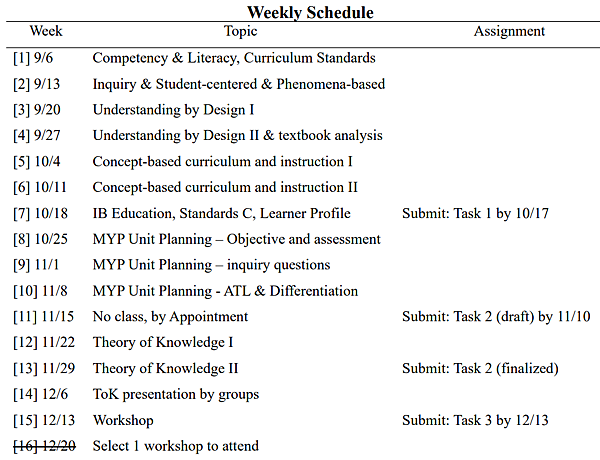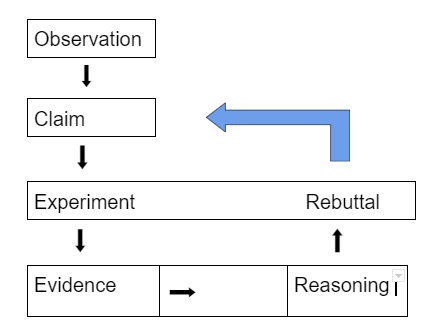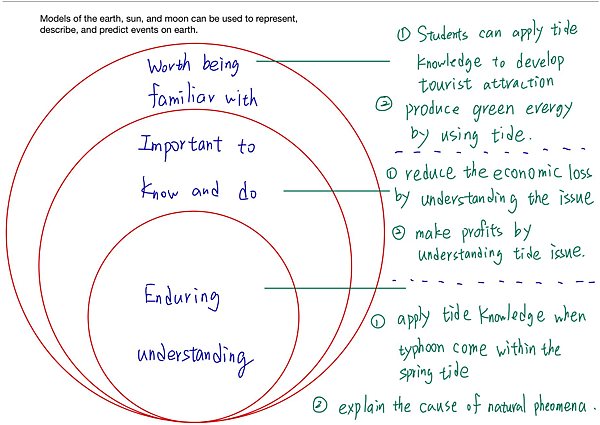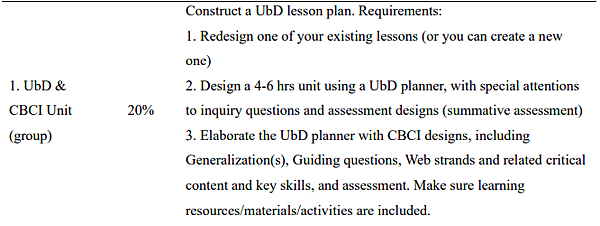這門課是IB 國際教育組必修,所以老師無論好壞你都要硬著頭皮修下去。先感謝我的同組夥伴互相扶持,如果沒有他們我可能期中就直接退選了,上這門課遇見志同道合的伙伴真的超級重要。先說,這門是EMI 課程,主要講述concept based curriculum design , backwards design, TOK 等等。老師三不五時會發佈課堂完後的作業。然後,剩下 70% 都是小組作業。我有點不太適應這門課的原因是,
第一: 我不太喜歡不準時下課的老師。老師常常重要的作業都在下課前說,然後說的不清不楚,我們也無法追問問題,讓我無所適從。再來就是老師常常會忘記開作業上傳區,有時是deadline過後才開,有種我們作業明明做完了,卻沒得繳交的感覺。讓我照三餐看Moodle真的很心煩。
其二是,老師是典型的我PPT講完,你們就會!老師,你是天才,我們不是。我們需要時間消化。有時候,老師發佈任務就說two minutes discussion, 有時可能是針對問題純討論,有時我們可能要看文章,查找資料,我只能說前置作業都不只兩分鐘,要理解老師的問題需要一點時間。
其三是,老師太忙了,其實本人就很分身乏術,無法給予學生什麼相關資源或建議。EMI 課程如果老師能提供其他相關的參考資料,翻譯書籍等幫助我們學習課程內容,我真心會感恩呀~。
備註:因為老師本人非常忙碌,在MOODLE 留言或是EMAIL 給他不一定會回應。因此,如果真的是有事情建議在課堂中詢問,如果有牽扯到分數的作業,建議自己要先上MOODLE 確認是否有相關資料,或是上傳作業區。

![]() 葉怡芬副教授
葉怡芬副教授
- 國立臺灣師範大學/師資培育學院/國際師培推動組長
- 國立臺灣師範大學/師資培育學院/國際文憑教育教師證照(IBEC)課程協調員
- E-mail:yyf521@ntnu.edu.tw
![]() 課程作業 20% (有時是要上傳小組討論的結果,有時候要上傳個人的心得等等。)
課程作業 20% (有時是要上傳小組討論的結果,有時候要上傳個人的心得等等。)

![]() 第一週作業 看影片寫3IDEAS 2 QUESTION 1 METAPHOR
第一週作業 看影片寫3IDEAS 2 QUESTION 1 METAPHOR
What is Competency-Based Education?
3 idea: competency-based education refers to student-centered, interdisciplinary design, and individual learning pace.
2 questions: how subject teachers work together to design a interdisciplinary course? How do teacher take care of those students who need more time to explore meanwhile to keep pace with the course schedule?
1 metaphor: as for me, competency-based education is just like mirage which is pretty idealistic and hard to explore and manipulate.
How can we ensure Authentic Assessment be successfully implemented by teachers and students (50-150 words)?
Authentic assessment means to set up questions in the real life and invite students to do it via what they have learned in class. If the students can finish the task successfully then which means they have achieved the goal that the teacher set up. Take Chinese class for an example, after we taught asking directions and we design a orienteering activity. Students have to finish the task by asking direction without their phone.
![]() 第2週作業
第2週作業
想一個INQUIRY MODEL 並配合實際教學
McNeill 和 Krajcik(2012)提出對於主張-證據-推理(CER)架構各要素的定義,「主張」是針對問題或結論所提出的陳述,學生在解決問題的過程中,藉由提出結論或答案以呈現主張;「證據」是支持該主張的科學數據,學生藉由觀察與測量所得到數據資料,並將數據作為證據,用以支持原先針對問題所提出的主張;「推理」是使用科學原理將證據與主張聯繫起來的理由,學生藉由推理解釋證據支持主張的原因,進而加深對於科學文本的理解。(李松濤,2022)

Project: Find one plant that is suitable for our campus
Inquiry Model:
A- observation

B- Claim: “ ” will grow better in this campus
C- Experiment: count the numbers
D-Evidence: good
E- Reasoning: find the reason why it is good for that plant
F- Rebuttal: put the plant into other environment
Reference:
1. 李松濤(2022),主張-證據-推理(Claim-Evidence-Reasoning, CER) 鷹架教學對於國小學童科學閱讀理解影響之研究,國立臺中教育大學科學教育與應用學系暑期在職進修專班碩士論文,台中市。
2. 仁愛國小植物檢索表,https://web.jaes.ntpc.edu.tw/html/p95/list0_test.html,查閱日期2023年9月14日。
![]() 第3週作業 + 第4週作業: UbD
第3週作業 + 第4週作業: UbD

![]() 第5週作業 CBCI reflection
第5週作業 CBCI reflection
1. how to distinguish knowledge, belief and opinion?
If we want to distinguish between knowledge, belief and opinion, we have to clarify the definition and offer a specific example to support it.
Firstly, according to Merriam-Webster, “knowledge is the circumstance or condition of apprehending truth or fact through reasoning.” For example, the Earth revolves around the Sun is knowledge due to Newton's laws of motion and Kepler's laws. Isaac Newton's laws of motion and law of universal gravitation played a significant role in providing theoretical support for the Earth revolves around the Sun. Besides, Kepler's laws contributed to the heliocentric model, which supports the idea that Earth revolves around the Sun. Therefore, we could indicate that knowledge is a fact that based on universally accepted and objectively verifiable facts.
Secondly, according to Merriam-Webster, “belief is the conviction of the relative truth of some statement or the reality of some being or phenomenon especially when based on examination of evidence.” For example, practicing mindfulness meditation improves mental well-being is a belief. This belief may be supported by scientific studies but its not universal. Thus, a belief is subjective and may be influenced by personal experiences, anecdotal evidence, or philosophical views.
Thirdly, according to Merriam-Webster, “opinion is a view, judgment, or appraisal formed in the mind about a particular matter.” For example, the movie was not as entertaining as the critics claimed is an opinion. the speaker is expressing a personal appraisal of the movie's entertainment level, and this judgment may not be universally shared, not supported by evidence. Opinion is based on personal taste, preferences, and individual experiences.
In conclusion, the distinctions among knowledge, belief, and opinion are crucial for understanding the nature of information and perspectives. Knowledge is rooted in universally accepted and objectively verifiable facts. Belief, on the other hand, involves conviction in the relative truth of a statement, often influenced by personal experiences and examination of evidence. Lastly, opinion, as a view or judgment formed in the mind, is inherently subjective and not necessarily supported by evidence.
2. Create a Knowledge Claim, find a picture, and offer a justification indicating what knowledge issue it may be and rationalize your ideas.
☆ Claim: Under the imperialization policy, the Japanese government believed that the Aboriginal (Atyal) gene had been diluted or diminished through the influence of the Japanese educational system.
☆ Knowledge issue:
the potential problem are hierarchy and personal biases.
Firstly, the phrase "imperialization policy" suggests a hierarchical relationship, indicating the influence or dominance of one group over another. Besides, educational system as a tool of influence reflecting a hierarchical power dynamic where the educational system is employed for specific purposes.
Secondly, the sentence “the Aboriginal (Atyal) gene had been diluted or diminished.” suggests a belief by the Japanese government without any scientific evidence could support their policy. Besides, it implies a hierarchy of genetic traits, with a potential bias toward the belief that the Japanese genetic makeup is superior or more desirable than that of the Aboriginal population.
In conclusion, examining historical issues requires a multifaceted approach. Analyzing each event from diverse perspectives allows for a comprehensive understanding of the entire historical context. This approach enables a more nuanced and complete interpretation, contributing to a richer and more accurate portrayal of historical events and their complexities.
![]() 小組作業
小組作業
前面兩個作業比較類似教案格式,老師有提供模板給我們,讓我們按圖索驥完成就好。
1. UbD & CBCI LESSON PLAN 4-6 HR

![]()
2. LESSON PLAN 20 HR

![]()
3. TOK UNIT DESIGN
這個作業老師只有給rubrics 其他就是看緣分;我們一開始討論三個小時,覺得卡關求助其他組同學共同討論後,有了基本想法,又討論了三個小時;
最後因為時間關係需要線上呈現,額外花了一個小時,將實體課程的內容轉化成線上。總共花了七個小時;真的有種升天的感覺。
其實東西不難,就是15分鐘的demo 只要做ppt 就好,但是因為不太清楚老師到底要什麼,所以卡關了。

![]()





 留言列表
留言列表